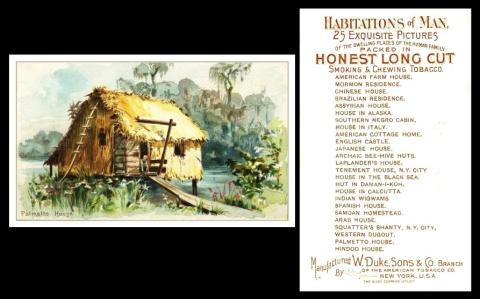
This structure is called a "Palmetto House", and it is made of parts of the fan palm, or saw palmetto.
Now if you put the phrase "Palmetto House" in a search engine today, you will find nothing like the one on this card. This seems to be because there has been a name change, for today we call this sort of house a palapa, a word which is actually Spanish, and means the stalk of a palm, especially the part where the leaf joins the stalk.
Further research has confused the issue still further, for it has discovered that a palapa is an open sided dwelling with a roof only of thatch - which is not the same as our building. However the palapa is built on stilts and most usually above the water, as showing here. And it seems likely that the artist had never seen one, and just filled in the sides without knowing any better - though to be honest the Spanish had never seen one either, they only heard of them when their explorers discovered the Phillippines, and brought back vague tales of palm leaved huts on the beach.
In our original World Tobacco Issues Index this set is listed as :
HABITATIONS OF MAN. Lg. Bkld. (25). Ref. USA/113. ... D76-23
And this text remains the same in our updated version of that work.
As far as USA/113, that is again Jefferson Burdick`s American Card Catalogue, where the set is described as :
113. Habitations of Man (25)
and valued at forty cents a card.
Now we know that the set was lithographed by the Giles Co., New York, and that they worked for Duke on several sets, including "Tricks with Cards" (1187), and "Presidential Possibilities" (N.124 - 1888),
By the way, you can see all the cards of this set at moviecard.com/N113 - and marvel at the curious dwellings which are portrayed, some of which seem also to be confections. The English Castle is the most intriguing, for it seems to be made of several structures, it is not quite Warwick, and not quite Alnwick.
